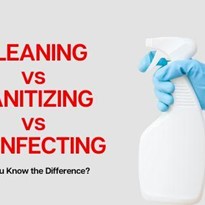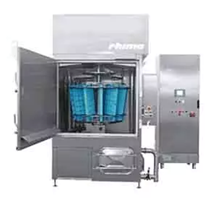What is Sanitisation?
Sanitising is the process of decreasing the number of microorganisms to a safe level. This safe level is determined by public health standards or guidelines.
Sanitisation is usually performed after cleaning to remove any visible signs of contamination and dirt. At the same time, it can also decrease the number of germs that are present.
Sanitising usually has to be performed frequently so that the “leftover” germs and pathogens don’t congregate together. Moreover, sanitisation is usually performed in places such as kitchens to prevent illnesses such as food poisoning.
A common method of sanitising is cleaning a surface then applying a sanitising solution. There are various chemical solutions that can sanitise.
However, it is important to always follow the instructions to ensure safety and proper usage. Examples of sanitisation products include soap and bleaching agents, though bleach can be a disinfectant depending on its concentration.

What Is Disinfection?
Disinfection is capable of killing microorganisms that can be present on various inanimate surfaces. Disinfectants have a more significant effect than sanitisation products do because they are more focused to target bacteria, diseases, and viruses.
In order to be effective, disinfectants require dwell time. This means that they must rest on the inanimate surface for a certain time period.
However, they can also be weakened by organic matter. This means that disinfectants require more care and attention should you use them.
Disinfection processes can be carried out in areas such as hospitals. This is because they normally use disinfectants to clean surfaces that may contain fluids.
This can include blood and bodily fluids that can possibly carry microorganisms.
What Is Sterilisation?
So, finally, what is sterilisation? Sterilisation is the most superior method compared to sanitisation and disinfection.
This is because not only can it kill microorganisms the same way disinfection can, but it can kill all forms of microorganisms. This includes both spores and pathogens.
While the sanitisation reduces the level of bacteria and disinfection and can eliminate harmful microorganisms, the sterilisation process is capable of completely killing ALL bacteria.
This includes both vegetative and spore, while preventing bacterial growth and reproduction.
Hence, this is why sterilisation is often used for instruments, especially if they are to be used for the human body. You will find that sterilisation techniques are often performed on dental and medical instruments.
However, they can even be used for instruments in tattoo shops and veterinary clinics! Examples of these instruments might include scalpels, scalers, surgical burs, forceps, and more.
It is no wonder that autoclaves are one of the best devices to use. This is because they are capable of performing sterilisation processes through the generation of saturated steam. This can kill the nastiest spores. It is because of this that autoclaves are used in various industries and settings.
However, it is also important to note that you must always conduct regular check-ups and maintenance on your autoclaves. This will ensure that it functions consistently and safely.

Conclusion
While most people think that sanitisation, disinfection, and sterilisation are the same, they are all actually very different. Sanitisation is often performed in settings such as households.
This is done in order to reduce the number of microorganisms to a safe level as prescribed by safety and public health guidelines.
On the other hand, disinfection can kill microorganisms on inanimate surfaces, such as those found in hospitals. This is important as bodily fluids can often be found on different inanimate surfaces.
However, disinfection is not capable of killing all types of bacteria, especially spores.
As such, sterilisation is a much more superior method compared disinfection. This is because it can kill ALL bacteria, vegetative and spore, to the point that they cannot grow and reproduce.
Autoclaves are critical tools because they can perform specialised sterilisation processes and come in a wide range of choices. They do this by killing microorganisms all the way to the spore level.










-160x160-state_article-rel-cat.png)








-205x205.jpg)
-205x205.jpg)







